Tradeoff Analysis between Spectral and Energy Efficiency Based on Sub-Channel Activity Index in Wireless Cognitive Radio Networks
Abstract
:1. Introduction
1.1. Motivation
1.2. Main Contribution
- The paper makes a more specific and in-depth description of the problems related to the trade-off between SE and EE for CCRNs. It is proved that despite additional energy consumption for the implementation of cognitive radio functions there is no inverse trade-off between SE and EE.
- In this paper, an optimal transmission power allocation strategy is formulated according to SAI in the form of an optimization problem in order to maximize the total utilization rate and minimize energy consumption in CCRNS.
- SAI is evaluated to describe primary user activities in CCRNs. And a sub-channel power allocation scheme is proposed in the SBSs to maximize the utility function of the SU.
2. The Notion of Spectral and Energy Efficiency in the Context of CCRNs
2.1. Energy Efficiency
2.2. Spectral Efficiency
3. Primary and Secondary User Activity Model
3.1. Activity Model of the Primary User
3.2. Activity Model of the Secondary User
4. Network Model
5. SE and EE Collaboration Technique
5.1. Analysis Related to Spectral Efficiency
5.2. Analysis Related to Energy Efficiency
6. Tradeoff Analysis of Spectral Efficiency and Energy Efficiency
6.1. General Relationship between SE and EE
6.2. Optimal Tradeoff Between SE and EE
- -
- We assume there is an only pair of SUs (a receiver and a transmitter) in the CRNs and also only pair of PUs (a receiver and a transmitter) with a sub-channel number set to K = 1.
- -
- The transmission power (Zt), the transmission relay (Zr), power detection (Zs), and the circuit power (Zc) are relative to time t.
- -
- The CCRN period is determined, we consider that the time of inactivity (OFF) and the transmission time (ON) for the CRNs are similar.
6.2.1. General Optimization in Case the Energy Efficiency (EE)
6.2.2. General Optimization in Case the Spectral Efficiency (SE)
6.3. Tradeoff between SE and EE in the CCRN
6.3.1. Tradeoff between SE and EE when relay power is taken into account in the CCRNs
Power Limit When Relay Power (Zr) Is Taken into Account in the CCRNs
6.3.2. Tradeoff between SE and EE when spectrum detection power is taken into Account in the CCRNs
Power Limit When Spectrum Detection (Zs) Is Taken into Account in the CCRNs
7. Simulation Results
8. Conclusions
Author Contributions
Funding
Acknowledgments
Conflicts of Interest
References
- Sadreddini, Z.; Çavdar, T. Performance analysis of dynamic spectrum management in cognitive radio networks. In Proceedings of the Meeting on Electric Electronics, Computer Science, Biomedical Engineering (EBBT), Istanbul, Turkey, 20–21 April 2017. [Google Scholar]
- Zhao, Y.; Hong, Z.; Luo, Y.; Wang, G.; Pu, L. Prediction-based spectrum management in cognitive radio networks. IEEE Syst. J. 2017, 99, 1–12. [Google Scholar] [CrossRef]
- Singh, J.S.P.; Singh, R.; Rai, M.K.; Singh, J.; Kang, A.S. Cooperative sensing for cognitive radio: A powerful access method for shadowing environment. Wirel. Pers. Commun. 2015, 80, 1363–1379. [Google Scholar] [CrossRef]
- Gangadharan, S.P. Translation in the Media Ownership Debate: The Work of Civil Society Groups and the Federal Communications Commission. Commun. Culture Crit. 2013, 6, 550–567. [Google Scholar] [CrossRef]
- Benidris, F.Z.; Benmammar, B.; Krief, F. A novel approach to spectrum management in cognitive radio networks using agent coalition formation. Int. J. Wirel. Mobile Comput. 2015, 9, 27–35. [Google Scholar] [CrossRef]
- Tsiropoulos, G.I.; Dobre, O.A.; Ahmed, M.H.; Baddour, K.E. Radio resource allocation techniques for efficient spectrum access in cognitive radio networks. IEEE Commun. Surv. Tutor. 2016, 18, 824–847. [Google Scholar] [CrossRef]
- Chatterjee, S.; Maity, S.P.; Acharya, T. On optimal sensing time and power allocation for energy efficient cooperative cognitive radio networks. In Proceedings of the International Conference on Advanced Networks and Telecommunications Systems (ANTS), Kolkata, India, 15–18 December 2015. [Google Scholar]
- Hammouda, M.; Akin, S.; Peissig, J. Effective capacity in cognitive radio broadcast channels. In Proceedings of the Global Communications Conference (GLOBECOM), Austin, TX, USA, 8–12 December 2014. [Google Scholar]
- Hu, H.; Zhang, H.; Liang, Y.C. On the spectrum-and energy-efficiency tradeoff in cognitive radio networks. IEEE Trans. Commun. 2016, 64, 490–501. [Google Scholar] [CrossRef]
- Zhang, J.; Zheng, F.C.; Gao, X.Q.; Zhu, H.B. Sensing-energy efficiency tradeoff for cognitive radio networks. IET Commun. 2014, 8, 3414–3423. [Google Scholar] [CrossRef]
- Xiong, C.; Lu, L.; Li, G.Y. Energy-efficient spectrum access in cognitive radios. IEEE J. Sel. Areas Commun. 2014, 32, 550–562. [Google Scholar] [CrossRef]
- Park, H.; Hwang, T. Energy-efficient power control of cognitive femto users for 5G communications. IEEE J. Sel. Areas Commun. 2016, 34, 772–785. [Google Scholar] [CrossRef]
- Ramamonjison, R.; Bhargava, V.K. Energy efficiency maximization framework in cognitive downlink two-tier networks. IEEE Trans. Wirel. Commun. 2015, 14, 1468–1479. [Google Scholar] [CrossRef]
- Zhang, W.; Wang, C.X.; Chen, D.; Xiong, H. Energy–spectral efficiency tradeoff in cognitive radio networks. IEEE Trans. Veh. Technol. 2016, 65, 2208–2218. [Google Scholar] [CrossRef]
- Sanchez, S.M.; Souza, R.D.; Fernandez, E.M.; Reguera, V.A. Rate and energy efficient power control in a cognitive radio ad hoc network. IEEE Signal Process. 2013, 20, 451–454. [Google Scholar] [CrossRef]
- Mili, M.R.; Musavian, L.; Hamdi, K.A.; Marvasti, F. How to increase energy efficiency in cognitive radio networks. IEEE Trans. Commun. 2016, 64, 1829–1843. [Google Scholar] [CrossRef]
- Halder, S.; Ghosal, A. A survey on mobile anchor assisted localization techniques in wireless sensor networks. Wirel. Netw. 2016, 22, 2317–2336. [Google Scholar] [CrossRef]
- Wang, S.; Wang, C. Joint optimization of spectrum and energy efficiency in cognitive radio networks. Dig. Commun. Netw. 2015, 1, 161–170. [Google Scholar] [CrossRef]
- Zarakovitis, C.C.; Ni, Q.; Spiliotis, J. Energy-efficient green wireless communication systems with imperfect CSI and data outage. IEEE J. Sel. Areas Commun. 2016, 34, 3108–3126. [Google Scholar] [CrossRef]
- Kilaru, S.; Narayana, Y.V.; Gandhiraja, R. Energy efficiency in Cognitive Radio Network: Green Technology towards next generation networks. In Microelectronics, Electromagnetics and Telecommunications; Springer: New Delhi, India, 2016; pp. 305–313. [Google Scholar]
- Orumwense, E.; Afullo, T.; Srivastava, V. Improving Energy Efficiency in Cognitive Radio Networks using a 2-step Cooperative Spectrum Sensing Approach. In Proceedings of the Southern African Telecommunication Networks and Application Conference, George, South Africa, 4–7 September 2016. [Google Scholar]
- Chen, X.; Ouyang, S. Energy-and spectral-efficiency trade-off in OFDMA-based cooperative cognitive radio networks. Int. J. Distrib. Sens. Netw. 2014, 10, 782648. [Google Scholar] [CrossRef]
- Ge, X.; Yang, J.; Gharavi, H.; Sun, Y. Energy efficiency challenges of 5G small cell networks. IEEE Commun. Mag. 2017, 55, 184–191. [Google Scholar] [CrossRef] [PubMed]
- Ge, X.; Yang, B.; Ye, J.; Mao, G.; Wang, C.X.; Han, T. Spatial spectrum and energy efficiency of random cellular networks. IEEE Trans. Commun. 2015, 63, 1019–1030. [Google Scholar] [CrossRef]
- Pimentel, H.P.; Cardieri, P. Spectral efficiency and aggregate capacity in cognitive radio networks-An application study. In Proceedings of the International Telecommunications Symposium (ITS), Sao Paulo, Brazil, 17–20 August 2014. [Google Scholar]
- Hong, X.; Wang, J.; Wang, C.X.; Shi, J. Cognitive radio in 5G: A perspective on energy-spectral efficiency trade-off. IEEE Commun. Mag. 2014, 52, 46–53. [Google Scholar] [CrossRef]
- Li, D.; Cheng, J.; Leung, V.C.M. Adaptive Spectrum Sharing for Half-duplex and Full-duplex Cognitive Radios: From the Energy Efficiency Perspective. IEEE Trans. Commun. 2018, 6, 5067–5080. [Google Scholar] [CrossRef]
- Agarwal, A.; Dubey, S.; Khan, M.A.; Gangopadhyay, R.; Debnath, S. Learning based primary user activity prediction in cognitive radio networks for efficient dynamic spectrum access. In Proceedings of the International Conference on Signal Processing and Communications (SPCOM), Bangalore, India, 12–15 June 2016. [Google Scholar]
- Luis, M.; Furtado, A.; Oliveira, R.; Dinis, R.; Bernardo, L. Towards a realistic primary users’ behavior in single transceiver cognitive networks. IEEE Commun. Lett. 2013, 17, 309–312. [Google Scholar] [CrossRef]
- Heydari, R.; Alirezaee, S.; Ahmadi, A.; Ahmadi, M.; Mohammadsharifi, I. Primary user activity prediction using the hidden Markov model in cognitive radio networks. In Proceedings of the International Symposium on Signals, Circuits and Systems (ISSCS), Iasi, Romania, 9–10 July 2015. [Google Scholar]
- Kim, S.W.; Pan, M.; Joshi, G.P.; Gazi, O.; He, J.; Coupechoux, M. Applications of cognitive radio networks: Recent advances and future directions. Int. J. Distrib. Sens. Netw. 2016. [Google Scholar] [CrossRef]
- Sabat, S.; Sharma, P.K.; Gandhi, A. Full-duplex cooperative spectrum sensing with primary user activity in cognitive radio networks. IETE Tech. Rev. 2017, 34, 4–14. [Google Scholar] [CrossRef]
- Saleem, Y.; Rehmani, M.H. Primary radio user activity models for cognitive radio networks: A survey. J. Netw. Comput. Appl. 2014, 43, 1–16. [Google Scholar] [CrossRef]
- Sadreddini, Z.; Çavdar, T.; Güler, E. Performance analysis of the dynamic switch system based on user activity in cognitive radio network. In Proceedings of the International Conference on Telecommunications and Signal Processing (TSP), Vienna, Austria, 27–29 June 2016. [Google Scholar]
- Ge, X.; Tu, S.; Mao, G.; Wang, C.X.; Han, T. 5G ultra-dense cellular networks. IEEE Wirel. Commun. 2016, 23, 72–79. [Google Scholar] [CrossRef]
- Wang, X.; Zheng, F.C.; Zhu, P.; You, X. Energy-efficient resource allocation in coordinated downlink multicell OFDMA systems. IEEE Trans. Veh. Technol. 2016, 65, 1395–1408. [Google Scholar] [CrossRef]
- Zhang, S.; Wu, Q.; Xu, S.; Li, G.Y. Fundamental green tradeoffs: Progresses, challenges, and impacts on 5G networks. IEEE Commun. Surv. Tutor. 2017, 19, 33–56. [Google Scholar] [CrossRef]
- Zhang, S.; Hafid, A.S.; Zhao, H.; Wang, S. Cross-layer rethink on sensing-throughput tradeoff for multi-channel cognitive radio networks. IEEE Trans. Wirel. Commun. 2016, 15, 6883–6897. [Google Scholar] [CrossRef]
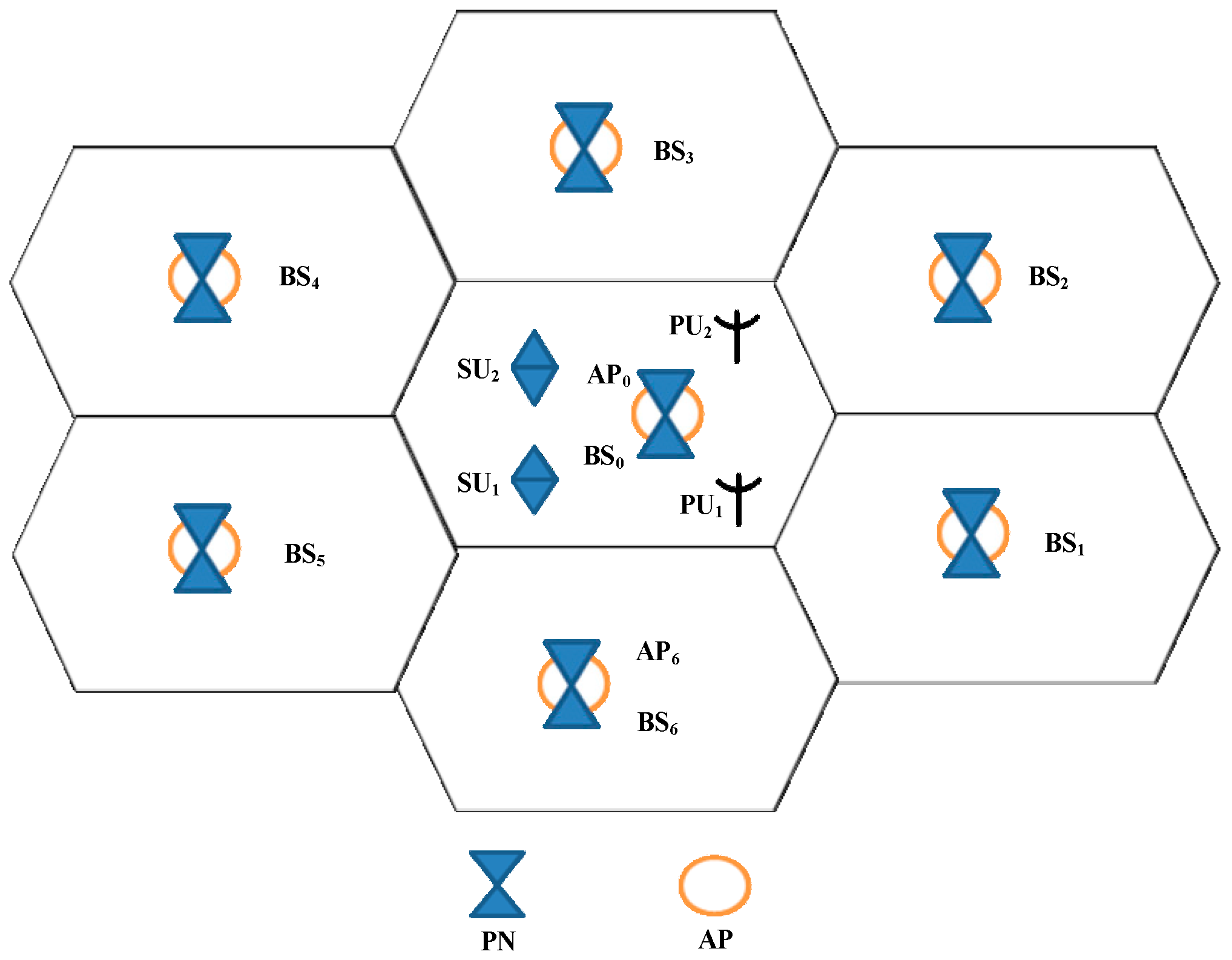
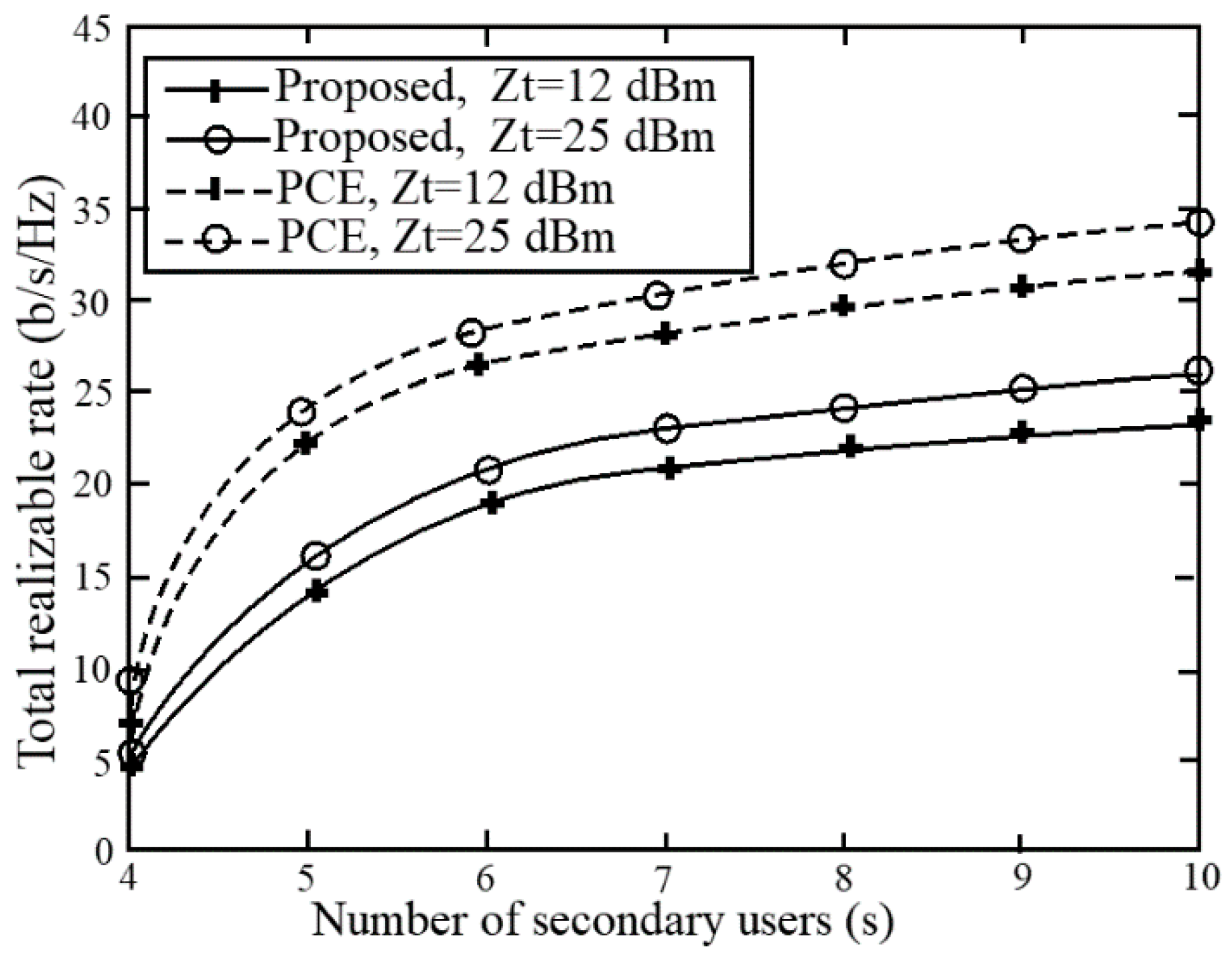
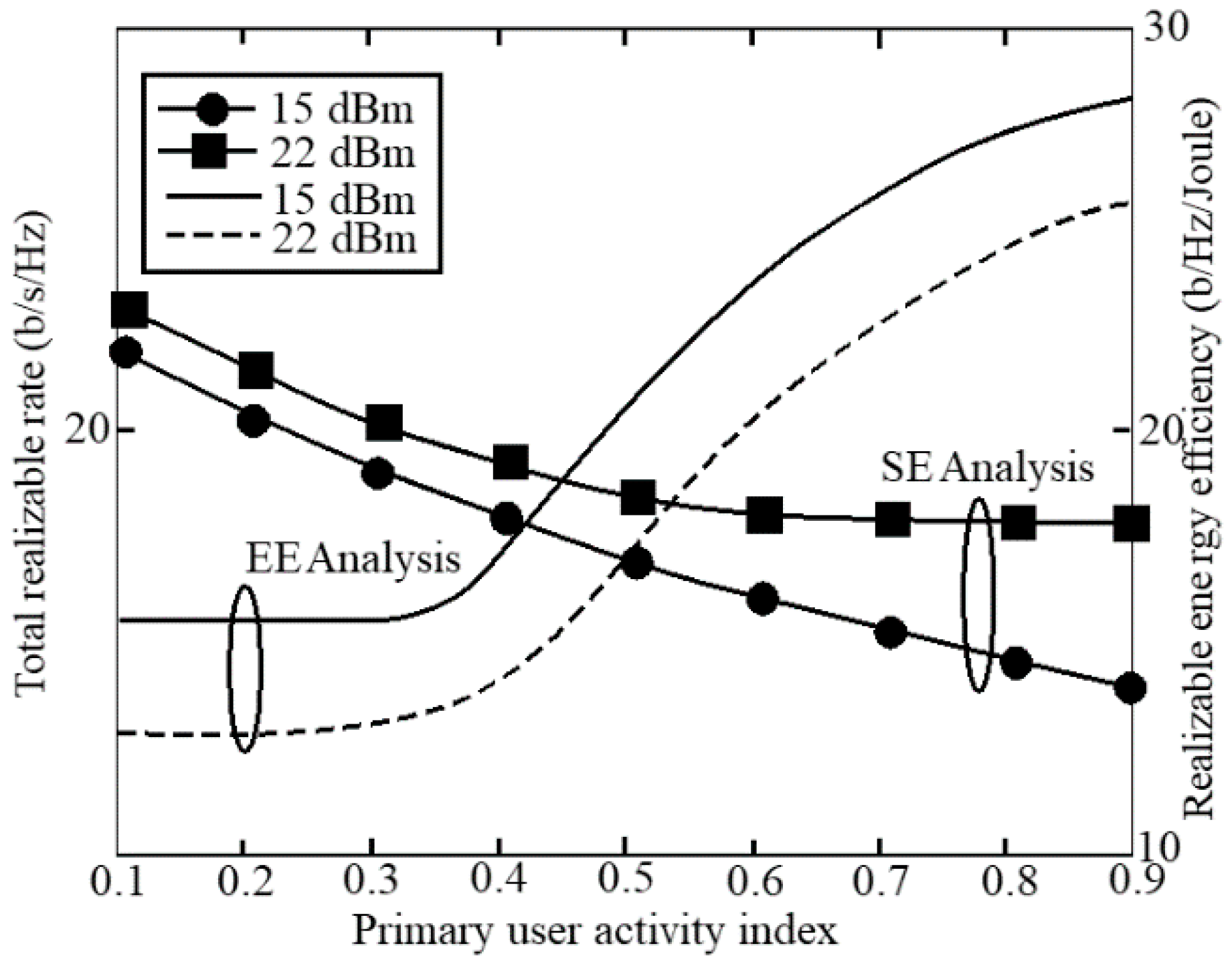
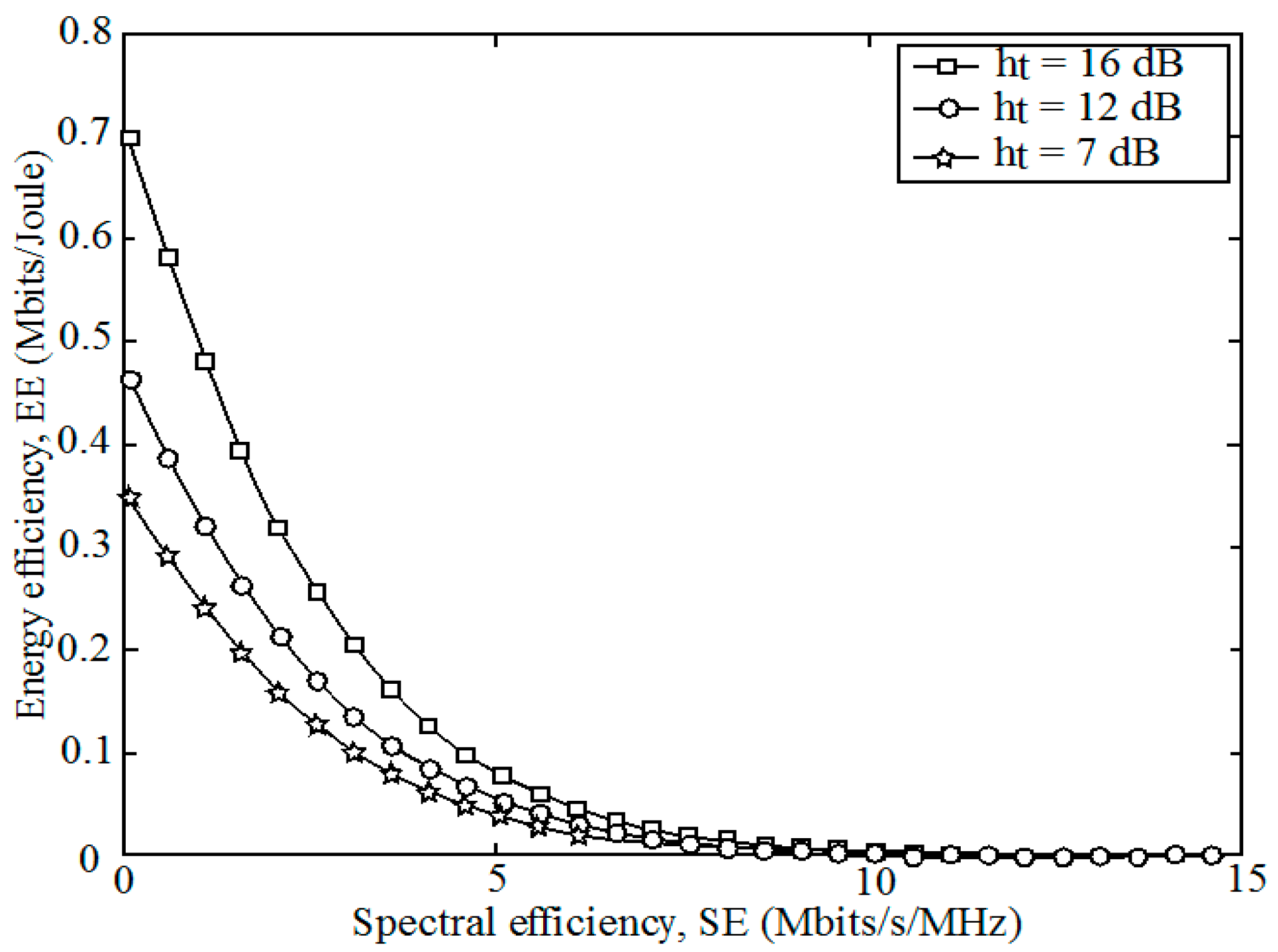
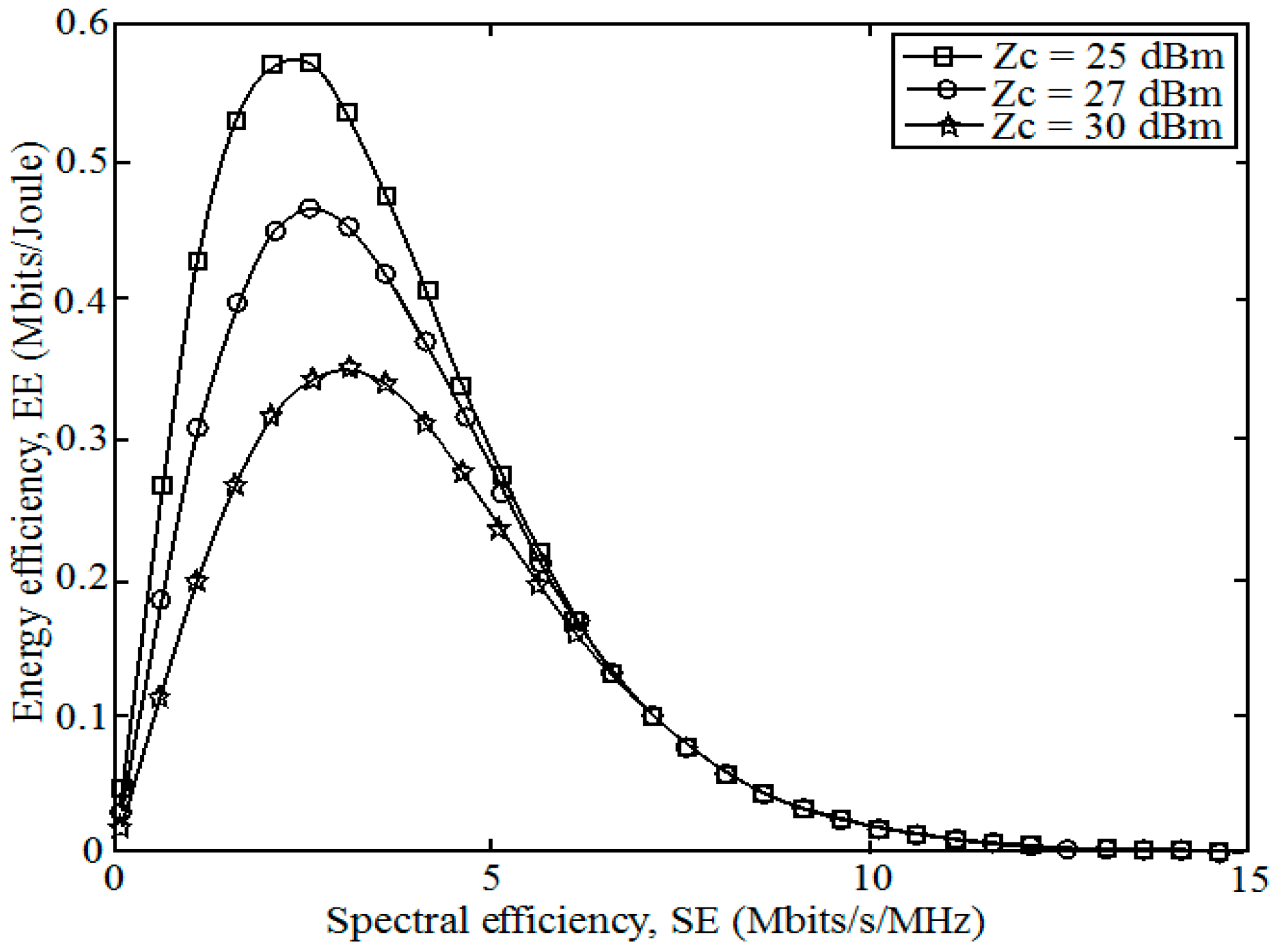

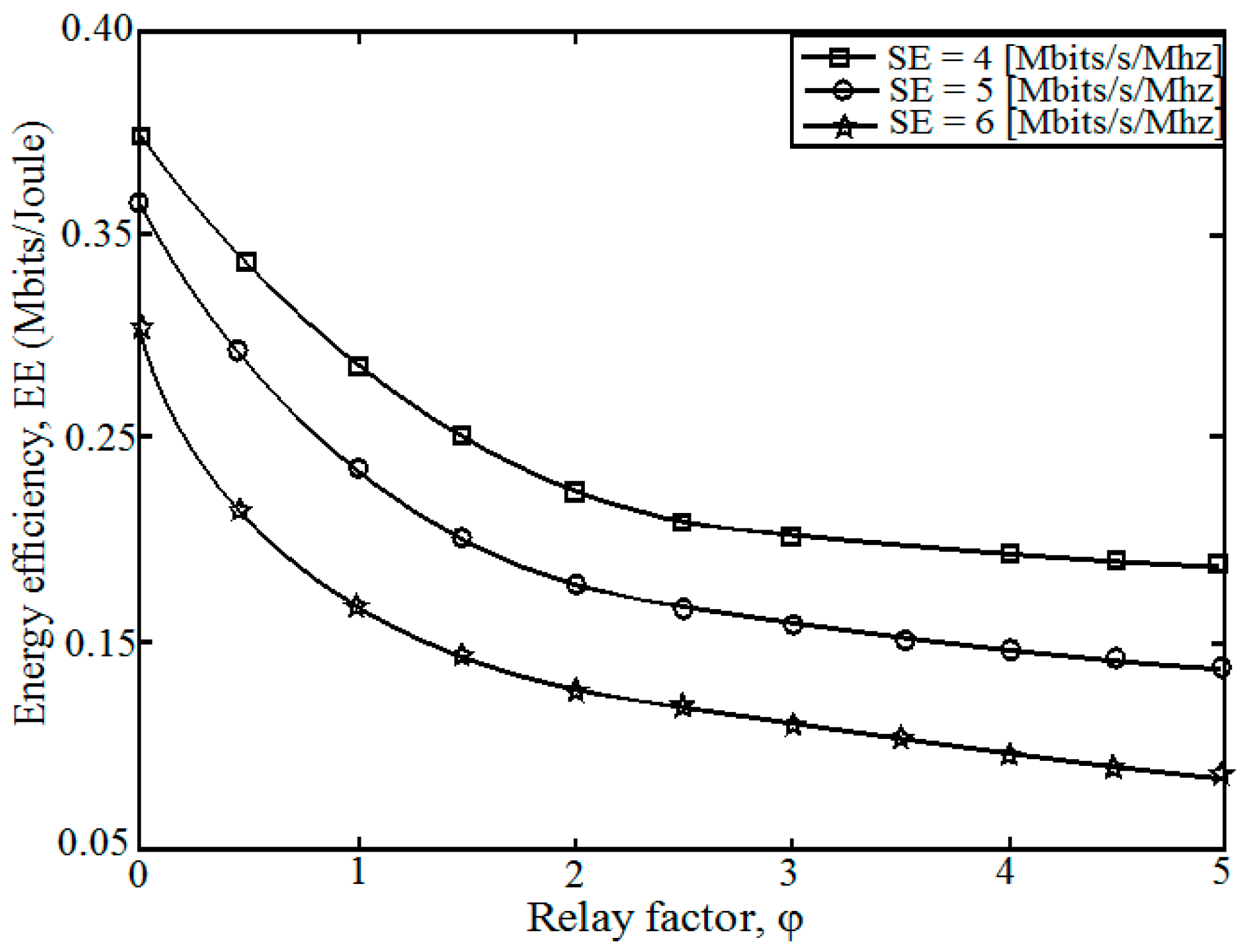
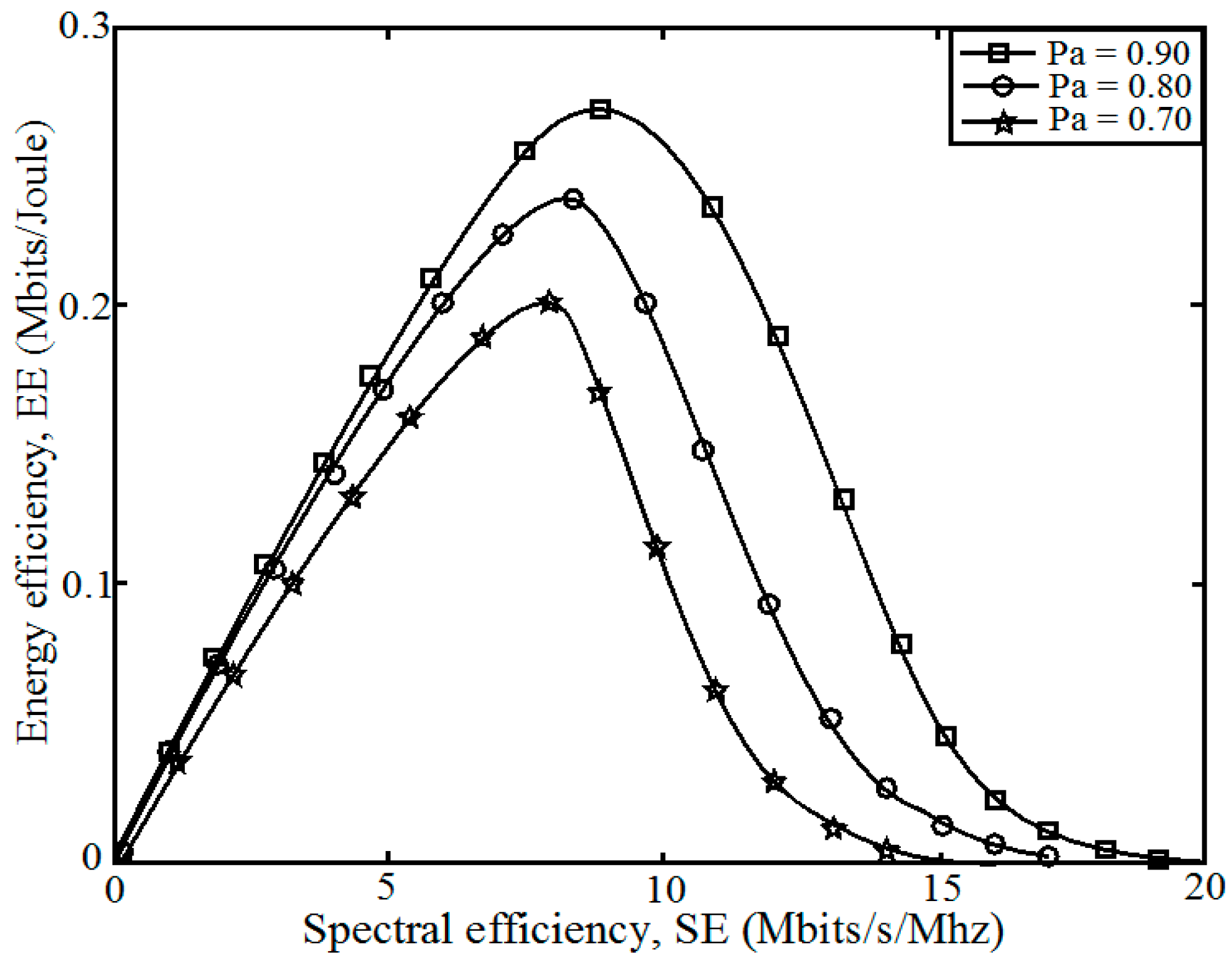

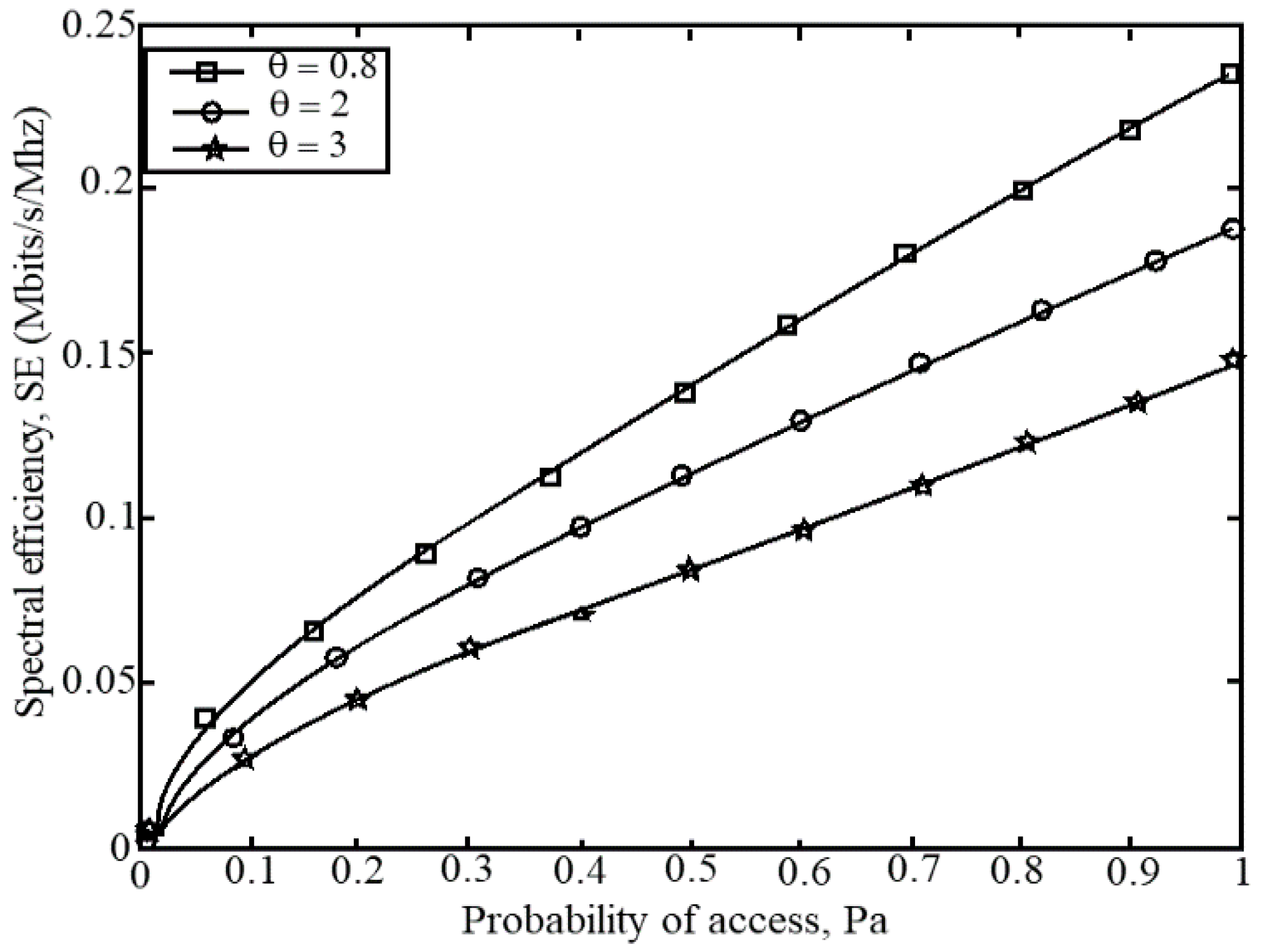
| Parameter | Value |
|---|---|
| Bandwidth | 124 kHz |
| Threshold of collision probability | [0.2 to 0.7] |
| Inactive channel probability | 0.6 |
| Period (P) | 0.01 s |
| Probability of false alarm (Pfa) | 0.01 |
| Probability of detection (Pd) | 92% |
| Interference threshold selected | 0.17 |
| Maximum transmission power (Zt) related to SBS | 27 dBm |
| Number of SUs | 7 |
| Number of subchannels | 32 |
| Channel model | Okumura-Hata |
© 2018 by the authors. Licensee MDPI, Basel, Switzerland. This article is an open access article distributed under the terms and conditions of the Creative Commons Attribution (CC BY) license (http://creativecommons.org/licenses/by/4.0/).
Share and Cite
Semba Yawada, P.; Trung Dong, M. Tradeoff Analysis between Spectral and Energy Efficiency Based on Sub-Channel Activity Index in Wireless Cognitive Radio Networks. Information 2018, 9, 323. https://doi.org/10.3390/info9120323
Semba Yawada P, Trung Dong M. Tradeoff Analysis between Spectral and Energy Efficiency Based on Sub-Channel Activity Index in Wireless Cognitive Radio Networks. Information. 2018; 9(12):323. https://doi.org/10.3390/info9120323
Chicago/Turabian StyleSemba Yawada, Prince, and Mai Trung Dong. 2018. "Tradeoff Analysis between Spectral and Energy Efficiency Based on Sub-Channel Activity Index in Wireless Cognitive Radio Networks" Information 9, no. 12: 323. https://doi.org/10.3390/info9120323
APA StyleSemba Yawada, P., & Trung Dong, M. (2018). Tradeoff Analysis between Spectral and Energy Efficiency Based on Sub-Channel Activity Index in Wireless Cognitive Radio Networks. Information, 9(12), 323. https://doi.org/10.3390/info9120323





